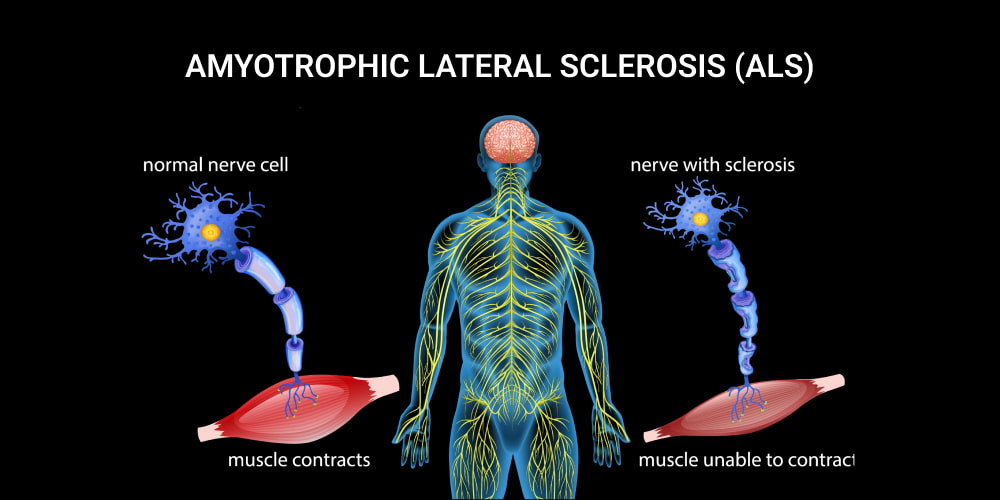Discovering that you or a loved one may have amyotrophic lateral sclerosis (ALS) can be overwhelming. However, understanding the primary stages of ALS diagnosis can help navigate this complex journey. Each step is crucial, from the first symptoms to the physical examination. They help identify and confirm the presence of ALS.
The journey begins by paying close attention to subtle signs. Muscle weakness or difficulty speaking are those very first signals. Recognizing these early signs is the first step to seeking medical attention. You will receive a comprehensive examination once you decide to see a specialist. These tests can help to assess muscle strength, reflexes, and coordination.
After the initial examination, additional tests will help confirm or deny the diagnosis. While the process may seem daunting, it is vital to understand the essential steps. Understanding the ALS diagnosis test allows individuals and their families to participate actively in the diagnosis and subsequent treatment. Let’s review each step, clarifying the path to an ALS diagnosis. Let’s shed light on the supportive measures available along the way.
The ALS Diagnosis Process
The process of amyotrophic lateral sclerosis diagnosis is like solving a puzzle. That’s what helps doctors put the pieces together. Then doctors can understand what’s going on in your body. It all starts with paying attention to the subtle whispers your body is sharing. These are small signs that something may be wrong. What follows is a visit to the doctor. They play the role of detectives, asking questions and running tests to uncover clues.
Then comes the tests. These are like snapshots, capturing a moment in time. So, these tests give a clearer picture of what’s going on. From electrical signals in the muscles to detailed scans. Each ALS diagnosis criterion adds another layer to the story. It’s a step-by-step journey, a collaborative effort between you and your medical team. You are all working together to understand and navigate the ALS diagnosis pathway.
ALS Diagnosis Tests
When it comes to diagnosing ALS, it’s like putting together a jigsaw puzzle. That is, each test makes an essential contribution to the complete picture. The various tests serve as necessary tools for medical professionals. These help to confirm and understand the complexity of amyotrophic lateral sclerosis. These tests play a crucial role in ruling out other possible diseases, ensuring an accurate diagnosis.
Think of it like detectives investigating a case. Each test provides unique clues that, when combined, lead to a definitive answer. Each ALS diagnosis criteria serves a specific purpose, from a neurological exam that tests muscle strength to specialized tests such as electromyography (EMG), which detects electrical activity in the muscles.
The doctor uses a variety of diagnostic tools. Then, they can gather comprehensive information. It allows them to make an informed decision about the presence of ALS and develop a suitable action plan. Let’s look at these tests’ importance and contribution to diagnosing ALS.
Electromyography (EMG)
Electromyography (EMG) is like a friendly conversation between your muscles and a small device. During this test, your doctor places tiny sensors on your skin. In some cases, these may be thin needles in your muscles. These sensors listen for electrical signals from your muscles. They help the doctor understand how well they are working. It is painless and provides valuable information for amyotrophic lateral sclerosis diagnosis. EMG plays a crucial role in diagnosis, offering clues that help build an overall picture of your health. So consider it a helpful conversation between your muscles and an EMG detective test!
MRI scans
Imagine traveling inside your body where magnetic waves create detailed images. It’s like a snapshot in time. It exactly happens during an MRI (magnetic resonance imaging) scan. It’s like having your body’s photo shoot! There are no X-rays, just a strong magnetic field and radio waves working together. This scan helps doctors see your brain and spinal cord and reveal hidden secrets. It is a painless adventure to see an ALS diagnosis. So, think of MRI as your body’s way of telling you about itself through breathtaking images.
Blood and Urine Tests
Let’s talk about blood and urine tests, the messengers of your body’s health. These tests are like detectives investigating evidence at a crime scene. In a blood test, a doctor takes a tiny sample from your arm that reveals the secrets of your body chemistry. Urine tests examine the stories your body tells with liquid waste. Both tests are like detectives working together. They provide valuable information to detect any hints of problems. It’s a quick and simple process. But these tests play an essential role in understanding your health history. They contribute significant pieces to the ALS diagnosis test.
Spinal Tap (Lumbar Puncture)
Now, let’s talk about a spinal tap, also known as a lumbar puncture. It resembles a superhero flying in to provide important information. During this test, a small amount of fluid is gently collected from your lower back. This fluid holds the secrets of your nervous system. It is one of the critical ALS diagnosis criteria. This test helps doctors understand any unusual activity. Don’t worry; it’s a quick procedure. But it provides clues to help build an overall picture of your health. Think of it as a brave explorer diving into the deep.
ALS Diagnosis Criteria
When finding out if a person has ALS, doctors follow the El Escorial Criteria guidelines. Think of these criteria as a checklist. They are a specific set of rules that help healthcare providers make a diagnosis. They focus on different areas of muscle weakness and how it progresses. It allows you to sort the puzzle together to see if there’s a disease.
Now, present the updated version of the revised El Escorial criteria. It’s like a refined checklist. It offers a more accurate picture of ALS diagnosis. In this updated version, doctors consider a wider range of symptoms. It makes the diagnostic process more comprehensive.
These criteria are like maps that guide doctors through the ALS diagnosis landscape. By following them, medical professionals can determine if a person meets the conditions for an ALS diagnosis, ensuring accuracy and clarity in understanding this complex neurological disease.
Amyotrophic Lateral Sclerosis Diagnosis Challenges
Amyotrophic lateral sclerosis diagnosis presents unique challenges. ALS is a complex mystery, and symptoms sometimes mimic those of other diseases. It can lead to a complex guessing game. Most importantly, it makes it difficult to determine the cause of specific symptoms. In addition, the progression of ALS occurs differently from person to person. It makes it even more difficult to diagnose.
Sometimes, the first signs are subtle and resemble normal pain or fatigue. As a result, patients may not immediately realize they need medical attention. In addition, there is no one accurate test for ALS. It makes the diagnostic process similar to putting together disparate pieces of a puzzle.
Despite these challenges, researchers are still conducting research. They are directing them to improve diagnostic methods and increase the accuracy of disease detection. Understanding these difficulties is crucial. It promotes a collaborative effort between patients and doctors to overcome the challenges. It is how ALS diagnosis tests will become even more accurate.
Conclusion
In conclusion, various tests are necessary to solve the mystery of this disease. You can find quality and accurate tests at Lone Star Neurology. Our Clinic specializes in a wide range of neurological diseases. Thanks to modern equipment and qualified specialists, you can easily identify any type of disease. In addition, we focus on an individual approach. It means that every person will feel comfortable despite their problems. Trust your health to Lone Star Neurology and live a happy life.
FAQ
What are the first signs of ALS?
Early signs of ALS include muscle weakness, twitching, and difficulty with fine motor skills. Their severity can vary from person to person. Symptoms often appear in the extremities and progress over time.
How long does it take to diagnose ALS?
ALS can take several months to diagnose. It’s all about investigating to rule out other diseases through various tests. Some may have similar symptoms.
Can ALS be misdiagnosed?
ALS can be misdiagnosed at the initial stage. All because its symptoms overlap with those of other diseases. A comprehensive examination is needed to make an accurate diagnosis. We recommend a consultation with a neurologist and specialized tests.












Please, leave your review
Write a comment: